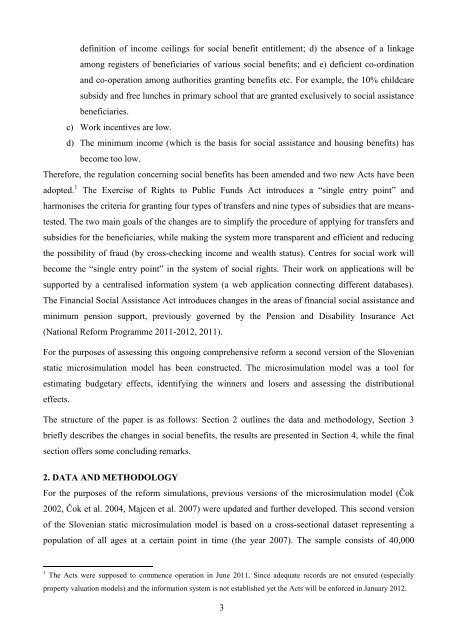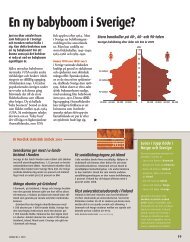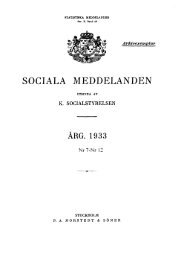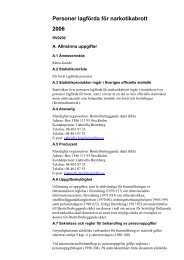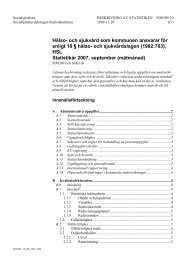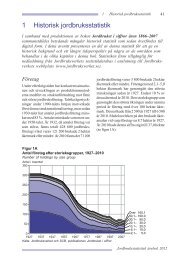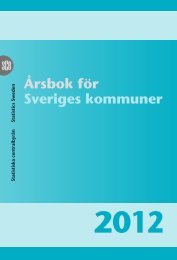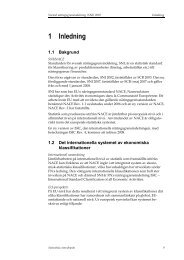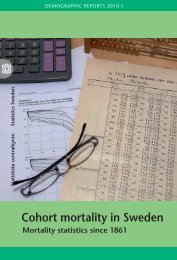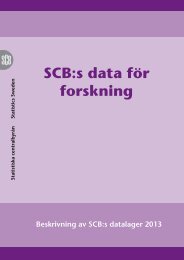Assessing the Benefits Reform in Slovenia Using a Microsimulation ...
Assessing the Benefits Reform in Slovenia Using a Microsimulation ...
Assessing the Benefits Reform in Slovenia Using a Microsimulation ...
Create successful ePaper yourself
Turn your PDF publications into a flip-book with our unique Google optimized e-Paper software.
def<strong>in</strong>ition of <strong>in</strong>come ceil<strong>in</strong>gs for social benefit entitlement; d) <strong>the</strong> absence of a l<strong>in</strong>kageamong registers of beneficiaries of various social benefits; and e) deficient co-ord<strong>in</strong>ationand co-operation among authorities grant<strong>in</strong>g benefits etc. For example, <strong>the</strong> 10% childcaresubsidy and free lunches <strong>in</strong> primary school that are granted exclusively to social assistancebeneficiaries.c) Work <strong>in</strong>centives are low.d) The m<strong>in</strong>imum <strong>in</strong>come (which is <strong>the</strong> basis for social assistance and hous<strong>in</strong>g benefits) hasbecome too low.Therefore, <strong>the</strong> regulation concern<strong>in</strong>g social benefits has been amended and two new Acts have beenadopted. 1 The Exercise of Rights to Public Funds Act <strong>in</strong>troduces a “s<strong>in</strong>gle entry po<strong>in</strong>t” andharmonises <strong>the</strong> criteria for grant<strong>in</strong>g four types of transfers and n<strong>in</strong>e types of subsidies that are meanstested.The two ma<strong>in</strong> goals of <strong>the</strong> changes are to simplify <strong>the</strong> procedure of apply<strong>in</strong>g for transfers andsubsidies for <strong>the</strong> beneficiaries, while mak<strong>in</strong>g <strong>the</strong> system more transparent and efficient and reduc<strong>in</strong>g<strong>the</strong> possibility of fraud (by cross-check<strong>in</strong>g <strong>in</strong>come and wealth status). Centres for social work willbecome <strong>the</strong> “s<strong>in</strong>gle entry po<strong>in</strong>t” <strong>in</strong> <strong>the</strong> system of social rights. Their work on applications will besupported by a centralised <strong>in</strong>formation system (a web application connect<strong>in</strong>g different databases).The F<strong>in</strong>ancial Social Assistance Act <strong>in</strong>troduces changes <strong>in</strong> <strong>the</strong> areas of f<strong>in</strong>ancial social assistance andm<strong>in</strong>imum pension support, previously governed by <strong>the</strong> Pension and Disability Insurance Act(National <strong>Reform</strong> Programme 2011-2012, 2011).For <strong>the</strong> purposes of assess<strong>in</strong>g this ongo<strong>in</strong>g comprehensive reform a second version of <strong>the</strong> <strong>Slovenia</strong>nstatic microsimulation model has been constructed. The microsimulation model was a tool forestimat<strong>in</strong>g budgetary effects, identify<strong>in</strong>g <strong>the</strong> w<strong>in</strong>ners and losers and assess<strong>in</strong>g <strong>the</strong> distributionaleffects.The structure of <strong>the</strong> paper is as follows: Section 2 outl<strong>in</strong>es <strong>the</strong> data and methodology, Section 3briefly describes <strong>the</strong> changes <strong>in</strong> social benefits, <strong>the</strong> results are presented <strong>in</strong> Section 4, while <strong>the</strong> f<strong>in</strong>alsection offers some conclud<strong>in</strong>g remarks.2. DATA AND METHODOLOGYFor <strong>the</strong> purposes of <strong>the</strong> reform simulations, previous versions of <strong>the</strong> microsimulation model (Čok2002, Čok et al. 2004, Majcen et al. 2007) were updated and fur<strong>the</strong>r developed. This second versionof <strong>the</strong> <strong>Slovenia</strong>n static microsimulation model is based on a cross-sectional dataset represent<strong>in</strong>g apopulation of all ages at a certa<strong>in</strong> po<strong>in</strong>t <strong>in</strong> time (<strong>the</strong> year 2007). The sample consists of 40,0001 The Acts were supposed to commence operation <strong>in</strong> June 2011. S<strong>in</strong>ce adequate records are not ensured (especiallyproperty valuation models) and <strong>the</strong> <strong>in</strong>formation system is not established yet <strong>the</strong> Acts will be enforced <strong>in</strong> January 2012.3


